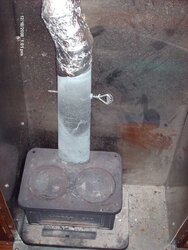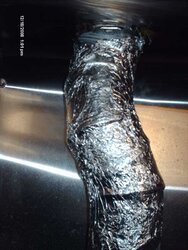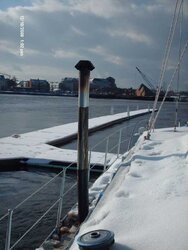Hey Everyone,
First post on the forum. I joined because I absolutely love heating with wood and have a question.
I used to have a wood stove in the house I grew up in as a child... it was primary heat and I'm very used to using one.
A few years ago, I got a wood stove as primary heat for my current home. My current home also happens to be a boat. Yes, I live on a boat.
I have had this stove on two different boats in the few years I've had it.
History:
The stove is a "Little Cod" (Google it if you want). It's a great little stove, putting out 29,000BTU, which keeps my boat warm. It's installed with single-wall metal stove pipe going from the stove to a "deck iron", which is the point the chimney exits the deck. The "deck iron" is filled with water and keeps the hot chimney from melting the fiberglass hull. Pretty cool, huh?
Above the deck, there is a 6' chimney with cap to keep rain out.
In the other boat, I had a CO detector, but without digital readout. The other boat was set up in a similar fashion with the same type of stove. I never had a CO alarm go off on the other boat.
The Problem:
When using this stove on my current boat at the beginning of this season, I had a CO reading of zero on my detectors (I have two since a boat is a small, confined space). Lately, I have been getting readings between 13PPM and 24PPM inside the boat ALL THE TIME when the stove is on.
I'm in here all day long because I have an internet business. I'm exposed to this level of CO all day and night 24/7.
Today, when lighting the stove, I noticed a little puff or two of smoke coming out of my elbow joint above the damper. It only seemed to happen when I lit the stove, but got me wondering if that's where my CO is coming from.
You can't smell any smoke inside the place.
Also, I don't get CO readings on extremely windy days, only when it's very still out.
What I've Done:
1) Wrapped the elbow with aluminum foil very tightly to try and seal any cracks in the joints
2) Tried running the stove with the damper more open and the vents more closed than normal to create "suction" inside the stove
3) Cleaned out the chimney 100% (it comes apart, so it's easy to do)
I just can't figure out why this is happening! Any ideas? I mean I can't smell a bit of smoke in here... I just keep getting readings, on both CO detectors of 13-24PPM all the time! I'm getting very frustrated!!
Do you think I had this kind of CO exposure all the time in the past, before I got the alarms with the digital readouts? It's never been bad enough to set off an alarm, but the constant low level exposure seems like it can't be too healthy. Is this normal??
First post on the forum. I joined because I absolutely love heating with wood and have a question.
I used to have a wood stove in the house I grew up in as a child... it was primary heat and I'm very used to using one.
A few years ago, I got a wood stove as primary heat for my current home. My current home also happens to be a boat. Yes, I live on a boat.
I have had this stove on two different boats in the few years I've had it.
History:
The stove is a "Little Cod" (Google it if you want). It's a great little stove, putting out 29,000BTU, which keeps my boat warm. It's installed with single-wall metal stove pipe going from the stove to a "deck iron", which is the point the chimney exits the deck. The "deck iron" is filled with water and keeps the hot chimney from melting the fiberglass hull. Pretty cool, huh?
Above the deck, there is a 6' chimney with cap to keep rain out.
In the other boat, I had a CO detector, but without digital readout. The other boat was set up in a similar fashion with the same type of stove. I never had a CO alarm go off on the other boat.
The Problem:
When using this stove on my current boat at the beginning of this season, I had a CO reading of zero on my detectors (I have two since a boat is a small, confined space). Lately, I have been getting readings between 13PPM and 24PPM inside the boat ALL THE TIME when the stove is on.
I'm in here all day long because I have an internet business. I'm exposed to this level of CO all day and night 24/7.
Today, when lighting the stove, I noticed a little puff or two of smoke coming out of my elbow joint above the damper. It only seemed to happen when I lit the stove, but got me wondering if that's where my CO is coming from.
You can't smell any smoke inside the place.
Also, I don't get CO readings on extremely windy days, only when it's very still out.
What I've Done:
1) Wrapped the elbow with aluminum foil very tightly to try and seal any cracks in the joints
2) Tried running the stove with the damper more open and the vents more closed than normal to create "suction" inside the stove
3) Cleaned out the chimney 100% (it comes apart, so it's easy to do)
I just can't figure out why this is happening! Any ideas? I mean I can't smell a bit of smoke in here... I just keep getting readings, on both CO detectors of 13-24PPM all the time! I'm getting very frustrated!!
Do you think I had this kind of CO exposure all the time in the past, before I got the alarms with the digital readouts? It's never been bad enough to set off an alarm, but the constant low level exposure seems like it can't be too healthy. Is this normal??


 I'll have to look that up. At least that would eliminate one possible source of leakage..
I'll have to look that up. At least that would eliminate one possible source of leakage..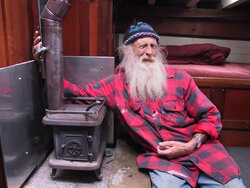
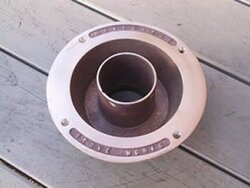
 The cap is female and the deck iron is male. So... it's leaking a bit. I will do something different next winter with that issue.
The cap is female and the deck iron is male. So... it's leaking a bit. I will do something different next winter with that issue.